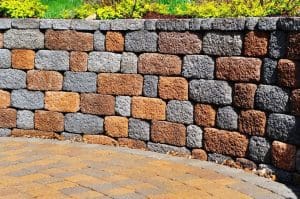
Don’t Ignore the Early Warning Signs of Damage
Retaining wall damage can build up slowly. True catastrophe is usually sudden. When your wall no longer retains, then property damage, personal injury and even death can occur.
Most homeowners are inclined to ignore these early warning signs:
- Rotting (if wood)
- Crumbling (if concrete)
- Soil Separation
- Water Pooling (look around the base)
- Fractures or shifting
The following tips outline some of the most important tips for retaining wall repair – and what steps you can take to optimize the return on your investment.
Overflowing Saturation
The pressure exerted by soil is substantial, and this same pressure will increase when soil is wet. If the ground behind the retaining wall is not well-drained, you will begin to experience failure. When water collects and puddles behind the retaining wall in the fill, the pressure against the wall can easily double. To prevent this issue from occurring, the surface needs to be properly graded away, directing the water away from or over the wall. Drainage channels and property compacted forces back-fill material should be installed behind the wall.
Foundation Settlement
Retaining walls are built to keep soil materials from falling. The soil underneath a retaining wall can begin to compress or subside causing the wall to settle. If the retaining wall settles enough, the entire wall can fail.
Material & Reinforcement
Retaining walls can be built from a variety of materials, including timber, concrete, stone and brick. A basic understanding of the laws of gravity is important, both when building new retaining walls and evaluating existing structures.Concrete retaining walls need to be properly reinforced to provide adequate strength.
Retaining Wall Design Flaws
Always invest in quality. When done correctly, retaining wall repair is extremely affordable. So resist the temptation to shop for deals or DIY solutions. As with most homeowner improvements, bad repairs and installation will cost more in the long run.
One size does not fit all. Find contractors that know Texas soils at Advanced Foundation Repair. Look for experts that specialize in soil stabilization. Not every material works for every home. The design and materials chosen can determine the length and warranty of your retaining wall.
To avoid these common mistakes, hire the right contractor for your retaining wall needs. This will ensure that every step, from the initial design to the installation, is done accurately and the wall is strong and secure.
